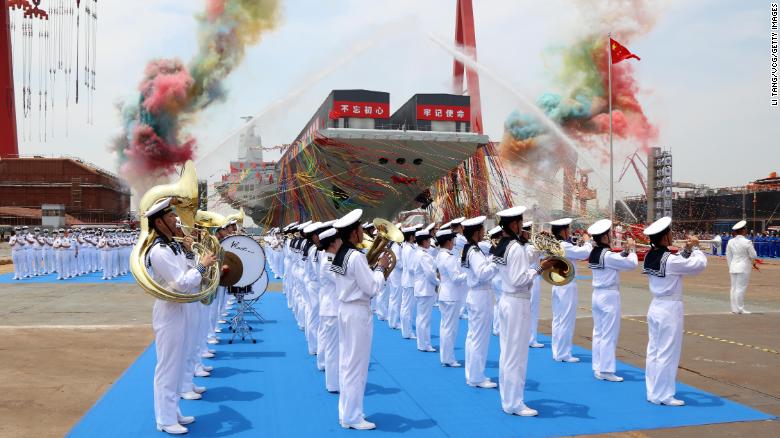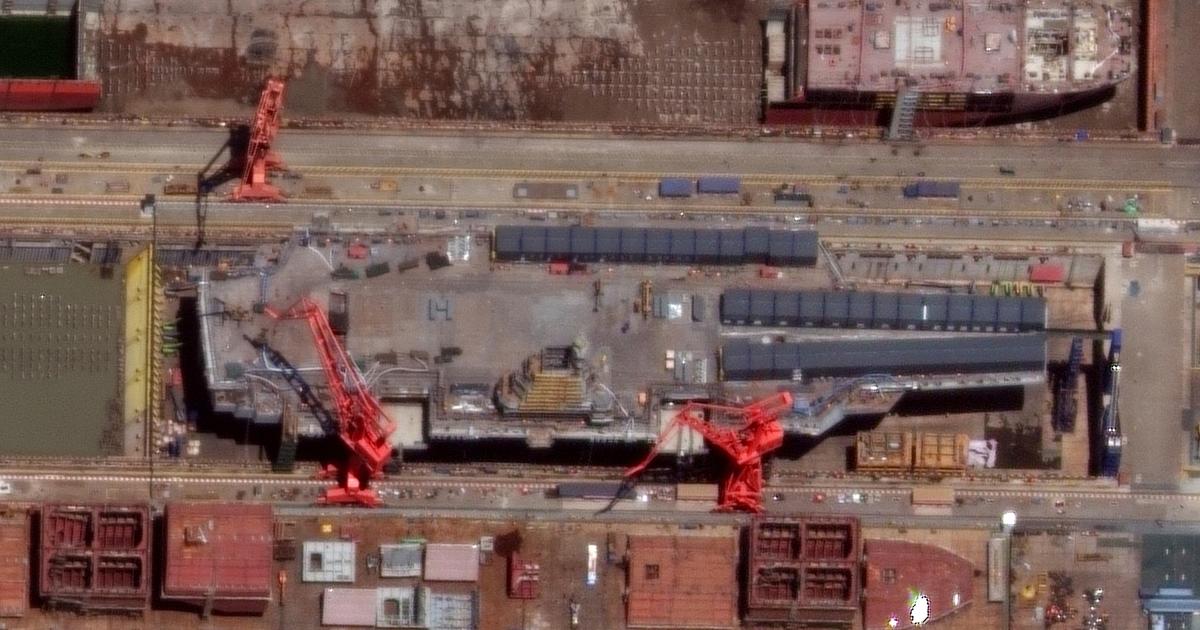Fujian, China's new advanced aircraft carrier 0:47
(CNN) --
China made a big statement about its naval ambitions with the recent launch of its third and most advanced aircraft carrier.
By far China's largest, most modern and most powerful aircraft carrier to date, the Fujian is the jewel in the 80,000-ton crown of a military expansion that has seen Beijing grow its navy to become the largest in the world. world.
Its new combat systems — such as an electromagnetic catapult-assisted launch system — show that China is rapidly closing in on the United States, experts say, and will give it the ability to launch more planes, faster and with more ammunition.
That should be enough to give any potential opponent pause, especially given China's growing aggression in its territorial disputes with Japan in the East China Sea, a host of Southeast Asian countries in the South China Sea, and his repeated harassment of the autonomous territory of Taiwan, where he has deliberately refused to rule out an invasion.
China's third aircraft carrier, the Fujian, at the Jiangnan shipyard on June 17.
Still, while Fujian's launch amid much fanfare was clearly a message to Beijing's rivals, analysts warn against swallowing too much publicity just yet.
advertising
First, the Fujian likely won't be operational for another three to four years, said Carl Schuster, a former US Navy captain and former director of operations at the US Pacific Command's Joint Intelligence Center. And even when operational, its size will make it an obvious target: any enemy will be well aware that sinking such an iconic ship would be as much a moral blow as it would be a military disaster for China.
The launching ceremony for China's third aircraft carrier, the Fujian, at the Jiangnan Shipyard in Shanghai on June 17.
Then there is the simple fact that, impressive as they may seem, aircraft carriers are not necessarily best suited for what experts see as the most plausible conflict scenarios in the near future, including clashes in the East and South China seas. and an invasion of Taiwan.
Essentially, experts say, the Fujian could be China's largest ship, but it's probably not the biggest issue on the minds of US naval commanders right now.
Here are four types of ships at China's disposal that arguably pose a far greater threat to US naval dominance.
China's Type 055 guided missile destroyer Nanchang in the Western Pacific on October 19, 2021.
Type 055 destroyer
Launched in 2017, these 13,000-ton stealth guided-missile destroyers are considered by many to be the most powerful surface combatants in the world.
Large enough to be considered a cruiser by NATO standards, the Type 055 is equipped with 112 vertical launch tubes that can be used to fire everything from anti-ship missiles to long-range land-attack missiles.
“This particular ship has a sophisticated design, stealth features, radars and a large inventory of missiles.
It's bigger and more powerful than most American, Japanese and South Korean destroyers," RAND Corp. Principal Analyst Timothy Heath told CNN in 2018 when Beijing launched two of the warships in a single day, a testimony to China's impressive shipbuilding capabilities.
A US Congressional Research Service report in March said at least 10 Type 055s are believed to have been launched or are under construction.
China's new high-tech aircraft carrier could be ready in early 2022, according to analysis of satellite images
The deployment of the Lhasa, the second of Beijing's five active Type 055s, to the Sea of Japan for drills amid rising tensions over Taiwan, was defended by China's state-run Global Times tabloid last week.
“The ship has reached its full operational capability and has demonstrated its ability to deter potential foreign military interference in the Taiwan Strait at a time when the United States and Japan have repeatedly provoked China over the Taiwan issue,” the Global reported. Times.
The power of the Type 055 was emphasized in images that emerged on social media in April.
It showed one launching what naval analyst HI Sutton said was a YJ-21 hypersonic anti-ship ballistic missile, a weapon often referred to as an "aircraft carrier killer."
The Global Times downplayed the images and described the missiles as part of the country's defensive strategy.
"If the United States doesn't make military provocations against China, including on the Taiwan issue, it doesn't need to worry about missiles," he said.
China's aircraft carrier Liaoning accompanied by navy frigates and submarines during an exercise in the South China Sea.
Type 039 Submarine
These Yuan-class subs are near-silent diesel-electric ships with capabilities that could be unwieldy for US military planners.
Beijing has built 17 of the Type 39A/B submarines, with plans to increase that total to 25 over the next three years, according to the US Department of Defense's 2021 report to Congress on China's military might.
"SS Type 039s provide formidable 'defense in depth'" in waters near China, "and appear to develop some capability to engage" US forces further out at sea, Schuster said.
The subs are equipped with air-independent propulsion (AIP), which means they don't need to surface as often to get the air needed for diesel combustion, which can then power their batteries.
"When operating on batteries, AIP-equipped submarines are nearly silent, with the only noise coming from the shaft bearings, propeller, and flow around the hull," wrote US Navy officials Michael Walker and Austin Krusz in a 2018 report for the U.S. Marine Institute Proceedings Magazine.
ANALYSIS |
The surprise appearance of a Chinese submarine in the Taiwan Strait highlights the risks of an unexpected incident
China is pushing to launch more super-quiet submarines, which are armed with anti-ship cruise missiles, according to the Defense Department report.
A powerful method of attack used by the Type 039 is to fire a "wake-homing" torpedo through the stern, or rear, of a target vessel.
The torpedo then follows the target ship's wake before exploding near its propulsion and steering systems.
Because surface ships detect submarines and torpedoes using sound waves, wake torpedoes are particularly difficult to defend against.
The advances in Chinese submarines come just as the US Navy is struggling with its anti-submarine capabilities.
Chief of Naval Operations Admiral Michael Gilday told Congress last month that the service wants to scrap nine of its littoral combat ships, some of the newest ships in the US fleet, because their anti-submarine systems were "not technically functional." .
merchant ferries
Merchant ferries may not be the first thing that comes to mind when you think of deadly naval capabilities, but therein lies their power.
To invade Taiwan, China would probably need to transport an invasion force of hundreds of thousands of men;
some analysts have suggested that more than a million would be needed.
Various analysts — and US government reports — have concluded that the People's Liberation Army (PLA) naval fleet is not up to the task.
But what China does have is a huge fleet of civilian ferries that could quickly be converted for military use and, according to some, may even have been designed for that possibility.
"China's largest ferry ship builder publicly stated in 2015 that one of its largest roll-on/roll-off ferries was built for dual military and civil purposes, and one of China's largest ferry operators has been similarly described as having a dual civilian-military development philosophy," Thomas Shugart, a former U.S. Navy submarine commander now a fellow at the Center for a New American Security, wrote in a 2021 essay for War on the Rocks.
He added that civilian ferry companies operating in the Yellow and South China seas have already been organized into auxiliary units of the PLA.
What are US warships doing sailing off the coast of China?
Crunching the numbers, Shugart said, was amazing.
He estimated that the use of civilian ships would give China an additional displacement of 1.1 million tons.
That figure is more than three times the displacement tonnage of all of China's amphibious assault ships combined.
And if China were to turn to Hong Kong's roll-on/roll-off carriers, it could gain an additional 370,000 tons of shipping, according to Shugart.
Is that enough to take Taiwan by force?
That's hard to know.
But Shugart said that he did answer one question.
"How many transports (ships) does the Chinese military have? Most likely, more than you think."
Chinese ships moored at Whitsun Reef in the South China Sea in 2021.
maritime militia
Shuttles aren't the only supposedly civilian ships military planners have on their radars.
Experts also accuse China of creating a maritime militia, made up of more than 100 vessels purportedly engaged in commercial fishing, to enforce its wishes in disputed seas.
The militia — which Beijing denies even exists — is made up of at least 122 vessels and probably as many as 174, according to the Center for Strategic and International Studies.
But the real number could be even higher.
Several experts suspected militia involvement when more than 200 Chinese fishing boats filled the waters around the Pentecost Reef in the South China Sea in early 2021. The reef is claimed by both China and the Philippines, which described the presence of the boats as a "clearly provocative action".
ANALYSIS |
Putin is back on the world stage at the Beijing BRICS summit
"The People's Armed Forces Maritime Militia does not fish," Schuster told CNN last year.
"They have automatic weapons on board and reinforced hulls, which makes them very dangerous at close range. Also, they have a top speed of around 18-22 knots, which makes them faster than 90% of the world's fishing boats." ".
The militia has two main parts: professional militia boats and actual fishing boats employed by the Chinese military under a subsidy scheme, according to a November report by the Asia Maritime Transparency Initiative at the Center for Strategic and International Studies (CSIS). , for its acronym in English).
Professionals lead activities such as harassing foreign drilling ships or blocking foreign fishing vessels, and subsidized fishermen exert pressure in numbers, according to the CSIS report.
And with the world's largest fishing fleet, China has plenty of reserves to draw on.
On that aircraft carrier again
Still, none of this is to say that the Fujian launch isn't a significant moment.
As in the United States, the aircraft carriers will eventually become the centerpiece of the PLA navy and a symbol of what the modern Chinese military is capable of, Schuster said.
"The Fujian launch should be seen for what it portends rather than its limited immediate impact," Schuster said.
China launches six-month manned mission as it cements its position as a global space power
"China has now launched three aircraft carriers and brought two to full operational status during a period in which the US Navy has struggled to bring a new unit to full operational status," he said.
Schuster was referring to the USS Gerald Ford, a
supercarrier
that has been plagued with problems since its commissioning in 2017 (already three years behind schedule).
The
supercarrier
has yet to make its first operational deployment, although it is expected this fall.
Meanwhile, China is going ahead.
“They are building their navy at a faster rate than the United States and all of its allies,” Schuster said.
"Imperfect, but a good foundation."
Aircraft carrier analysis







